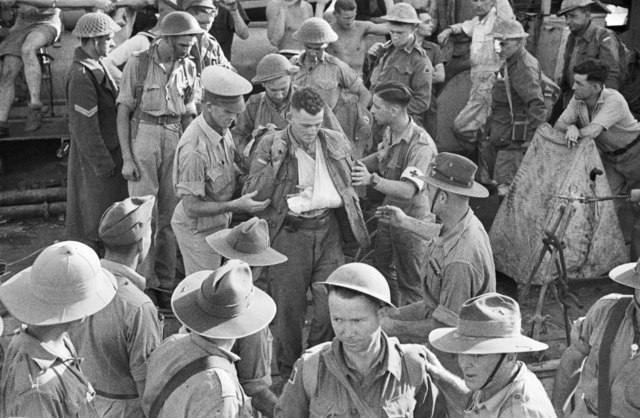2/1st Machine Gun Battalion (Australia)
The 2/1st Machine Gun Battalion was a battalion of the Australian Army that was raised for service during World War II as part of the 6th Division. When it was formed on 14 December 1939, its component companies were spread across several Australian states, but it was later concentrated at Ingleburn, New South Wales, where it completed basic training in the early months of the war. In mid-1940, the battalion embarked for overseas, bound initially for the Middle East, but following the Fall of France it was diverted to the United Kingdom. Along with a larger contingent of Australians, it helped to bolster the island's garrison, undertaking defensive duties during a period when it was expected that the Germans might launch a cross-Channel invasion.
Machine gunners from the 2/1st at Balikpapan, July 1945
King George VI inspecting the skills of one of the 2/1st's machine gunners, 1940
Members of 'A' Company, 2/1st Machine Gun Battalion, rest at Skindewai during the march from Bulolo to Nassau Bay, 1943
The 6th Division was an infantry division of the Australian Army. It was raised briefly in 1917 during World War I, but was broken up to provide reinforcements before seeing action. It was not re-raised until the outbreak of World War II, when it was formed as a unit of the Second Australian Imperial Force. Throughout 1940–41 it served in the North African Campaign, the Greek campaign, on Crete and in Syria, fighting against the Germans, Italians and Vichy French. In 1942, the division left the Middle East and returned to Australia to meet the threat of Japan's entry into the war. Part of the division garrisoned Ceylon for a short period of time, before the division was committed to the New Guinea campaign. In New Guinea, its component brigades had a major role in the successful counter-offensive along the Kokoda Track, at Buna–Gona and around Salamaua–Lae in 1942–43. Throughout late 1943–44, the division was re-organised in Australia before being committed as a complete formation to one of the last Australian operations of the war around Aitape–Wewak in 1944–45.

22 January 1941. Members of 'C' Company, 2/11th Infantry Battalion, having penetrated the Italian outer defences at Tobruk and attacked anti-aircraft positions, assemble again on the escarpment at the south side of the harbour. (Photographer: Frank Hurley.)
Troops from the 2/2nd Infantry Battalion enter Bardia.
6th Division evacuees arrive in Alexandria after being taken off Crete, 2 June 1941
Typical country in the Wau–Mubo area







